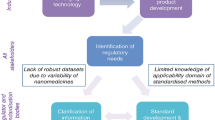Abstract
Intestinal absorption of neocarzinostatin (NCS) and smancs (copolystyrene maleic acid-conjugated NCS), in aqueous and oily formulations, was investigated after oral administration in mice. Blood concentrations of NCS and smancs were determined with a cytotoxicity assay employing the highly sensitive Epstein–Barr (EB) virus-transformed B-lymphoblastoid cell line, TK/B. Smancs was more efficiently absorbed from a medium-chain triglyceride solution (oily smancs) than from an aqueous solution in phosphate-buffered saline (PBS). The maximum blood concentration and the area under the concentration curve versus time course (AUC) of oily smancs were 9 and 11 times greater than those of the aqueous form of smancs, respectively. At 5 hr after administration of oily smancs, 0.044% of the total smancs dose was found in blood, whereas the parent compound NCS was not detectable at any time. When oily smancs was administered orally to sarcoma 180 tumor-bearing mice, a selective accumulation of smancs in tumor tissue was observed. These results indicated that a biologically active protein, which cannot be used orally, may be rendered orally active drug by conjugation with a hydrophobic polymer in combination with an oily formulation.
Similar content being viewed by others
REFERENCES
H. Maeda, Y. Matsumura, T. Oda, and K. Sasamoto. In R. E. Feeney and J. R. Whitaker (eds.), Protein Tailoring for Food and Medical Uses, Marcel Dekker, New York, 1986, pp 353–382.
H. Maeda, J. Takeshita, and R. Kanamaru. Int. J. Peptide Protein Res. 14:81–86 (1979).
Y. Inada, T. Yoshimoto, A. Matsushima, and Y. Saito. Trends Biotechnol. 4:68–73 (1986).
H. Maeda, M. Ueda, T. Morinaga, and T. Matsumoto. J. Med. Chem. 28:455–461 (1985).
H. Maeda, T. Matsumoto, T. Konno, K. Iwai, and M. Ueda. J. Protein Chem. 3:181–193 (1984).
T. Konno, H. Maeda, H. Iwai, K. Tashiro, S. Maki, T. Morinaga, M. Mochinaga, T. Hiraoka, and I. Yokoyama. Eur. J. Cancer Clin. Oncol. 19:1053–1065 (1983).
K. Iwai, H. Maeda, and T. Konno. Cancer Res. 44:2115–2121 (1984).
F. Suzuki, Y. Okuno, Y. Maeda and H. Maeda. Jpn. J. Cancer Chemother. 14:3305–3312 (1987) (in Japanese).
H. Maeda and K. Kuromizu. J. Biochem. 81:25–35 (1977).
Y. Matsumura and H. Maeda. Cancer Res. 46:6387–6392 (1986).
H. Maeda and Y. Matsumura. In K. Kimura, K. Ohta, and K. Yamada (eds.), Cancer Chemotherapy. Challenges for the Future, Vol. 4, Excerpta Medica, Amsterdam, 1989, pp. 42–50.
W. A. Walder, K. J. Isselbacher, and K. J. Bloch. J. Immunol. 111:221–226 (1973).
R. K. Gupta and D. J. Morton. Cancer Res. 35:58–62 (1975).
A. L. Warshaw, W. A. Walker, R. Correll, and K. J. Isselbacher. Lab. Invest. 25:675–684 (1971).
W. E. Balfour and R. S. Comline. J. Physiol. 148:77–78 (1959).
A. Yamashita, H. Ohtsuka, and H. Maeda. Immunopharmacology 5:209–220 (1983).
M. Sekine, H. Terashima, K. Sasahara, K. Nishimura, R. Okada, and S. Awazu. J. Pharmacobio-Dyn. 8:286–295 (1985).
J. R. Senior. Am. J. Med. Sci. 2:75–80 (1969).
H. Maeda and Y. Matsumura. Crit. Rev. Ther. Drug Carrier Syst. 6:193–210 (1989).
Author information
Authors and Affiliations
Rights and permissions
About this article
Cite this article
Oka, K., Miyamoto, Y., Matsumura, Y. et al. Enhanced Intestinal Absorption of a Hydrophobic Polymer-Conjugated Protein Drug, Smancs, in an Oily Formulation. Pharm Res 7, 852–855 (1990). https://doi.org/10.1023/A:1015917000556
Issue Date:
DOI: https://doi.org/10.1023/A:1015917000556




